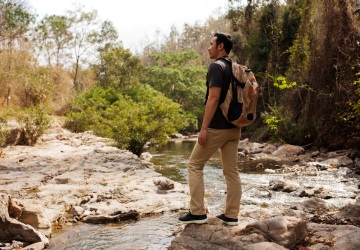How to Plan a Solo Expedition in the Wilderness: Survival and Safety Tips
Embarking on a solo expedition in the wilderness is an exhilarating yet challenging endeavor that requires careful planning and preparation. The solitude and connection with nature can be incredibly rewarding, but it's essential to prioritize your safety and survival. Whether you're an experienced outdoors enthusiast or a beginner looking for an adventure, here's a comprehensive guide on planning a solo expedition in the wilderness, complete with valuable survival and safety tips. This article will delve into each crucial aspect, providing you with a step-by-step roadmap to ensure a successful and secure solo wilderness experience.
Research and Location Selection
The first step in planning a successful solo wilderness expedition is thorough research and careful location selection. Identify regions that align with your skill level and interests. Consider factors like terrain, weather patterns, wildlife, and accessibility. Opt for an area with a manageable difficulty, especially if you're new to solo expeditions. Once you've chosen your location, delve into detailed maps, topographical information, and trail routes. Familiarize yourself with the surroundings to anticipate potential challenges and plan alternative routes.
Additionally, I gather insights from fellow adventurers through online forums, guidebooks, and blogs. These real-life experiences can provide invaluable information about the area's conditions, unexpected obstacles, and essential gear. Your research should give you a comprehensive understanding of the environment, equipping you to make informed decisions throughout your journey.
Skill Assessment and Training
Assessing your skills and capabilities is vital before a solo wilderness expedition. Be honest about your outdoor skills, physical fitness, and mental preparedness. Solo adventures require self-reliance, so ensure you possess basic survival skills such as fire-making, shelter-building, navigation, and first aid. If you need more proficiency in any of these areas, consider undergoing training before setting out.
Enrolling in wilderness survival courses, orienteering workshops, and first aid training can boost your confidence and competence. These experiences will equip you with essential techniques and knowledge, making you better equipped to handle unforeseen situations. Moreover, practicing these skills in a controlled environment under the guidance of experts can help you remain calm and composed when faced with challenges in the wilderness.
Gear Selection and Packing

Your gear choice can significantly impact your safety and comfort during a solo wilderness expedition. Compile a comprehensive gear list tailored to the specific requirements of your chosen location and the expected weather conditions. Start with the basics: a sturdy backpack, a reliable tent, a warm sleeping bag, and a comfortable sleeping pad. As a solo traveler, lightweight and compact gear is essential to ensure a manageable load.
Prioritize multipurpose items such as a versatile knife, a high-quality headlamp, and a compact stove for cooking. Pack adequate clothing layers to accommodate varying temperatures and weather changes. Remember to include a reliable water filtration system to ensure a consistent, clean water supply. Research the flora and fauna of the area to determine if bear-resistant containers or other protective gear are necessary.
Emergency Planning and Communication
No matter how well-prepared you are, emergencies can still arise. Establish a detailed emergency plan before departing for your expedition. Share your itinerary with a trusted friend or family member, including your intended route and expected return date. This information can be crucial for search and rescue teams if you go missing.
Carry multiple means of communication, such as a satellite messenger or a Personal Locator Beacon (PLB), which can transmit distress signals even in remote areas without cellular coverage. Familiarize yourself with how to use these devices before you set out. Also, learn basic wilderness first aid skills and pack a comprehensive kit addressing potential injuries, allergies, and medical conditions.
Navigation and Route Planning
Navigating through the wilderness requires more than a map and a compass. While these tools are essential, modern technology has introduced GPS devices and navigation apps to enhance route planning and tracking capabilities. However, always have a backup plan in case your electronic devices fail. Familiarize yourself with the terrain features and landmarks described on your maps to avoid getting lost.
Consider factors like elevation changes, water sources, and potential camping spots when planning your route—plan for contingencies by identifying bailout points or alternative ways. Be cautious when relying solely on marked trails, as they might need to be better-maintained or easily distinguishable. Trust your navigation skills, and if you find yourself off course, don't hesitate to retrace your steps or use your tools to pinpoint your location.
Leave No Trace Principles
Responsible outdoor exploration is essential for preserving the natural beauty of wilderness areas. Familiarize yourself with the Leave No Trace principles: Plan and prepare, travel and camp on durable surfaces, dispose of waste properly, leave what you find, minimize campfire impact, respect wildlife, and be considerate of other visitors. Adhering to these principles minimizes your ecological footprint and contributes to preserving the wilderness for future generations.
Mental Preparedness and Adaptability

Surviving in the wilderness isn't just about physical prowess, mental preparedness, and adaptability. Solo expeditions can be mentally challenging, as isolation and unexpected situations can test your resilience. Before embarking on your journey, develop a positive mindset and visualize potential challenges, along with your successful navigation. Practice meditation, mindfulness, and other relaxation techniques to help you remain focused and calm in stressful situations.
Flexibility is vital when exploring the wilderness, as conditions can change rapidly. Embrace uncertainty and adapt your plans accordingly. Allow room for spontaneity and exploration, but always prioritize your safety. Listen to your instincts and take breaks to recharge physically and mentally.
Conclusion:
In conclusion, planning a solo expedition in the wilderness is a multifaceted endeavor that demands meticulous preparation, careful consideration of your skills and gear, and a strong focus on safety. By conducting thorough research, acquiring essential skills, selecting appropriate equipment, and practicing responsible outdoor ethics, you can embark on a rewarding journey that not only challenges you but also connects you with the awe-inspiring beauty of the natural world. Remember, the wilderness is a place of wonder and adventure, but your safety should always remain paramount.









